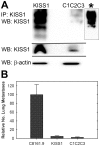Furin is the major proprotein convertase required for KISS1-to-Kisspeptin processing
- PMID: 24454770
- PMCID: PMC3890299
- DOI: 10.1371/journal.pone.0084958
Furin is the major proprotein convertase required for KISS1-to-Kisspeptin processing
Abstract
KISS1 is a broadly functional secreted proprotein that is then processed into small peptides, termed kisspeptins (KP). Since sequence analysis showed cleavage at KR or RR dibasic sites of the nascent protein, it was hypothesized that enzyme(s) belonging to the proprotein convertase family of proteases process KISS1 to generate KP. To this end, cell lines over-expressing KISS1 were treated with the proprotein convertase inhibitors, Dec-RVKR-CMK and α1-PDX, and KISS1 processing was completely inhibited. To identify the specific enzyme(s) responsible for KISS1 processing, mRNA expression was systematically analyzed for six proprotein convertases found in secretory pathways. Consistent expression of the three proteases - furin, PCSK5 and PCSK7 - were potentially implicated in KISS1 processing. However, shRNA-mediated knockdown of furin - but not PCSK5 or PCSK7 - blocked KISS1 processing. Thus, furin appears to be the essential enzyme for the generation of kisspeptins.
Conflict of interest statement
Figures




Similar articles
-
Role of PCSK5 expression in mouse ovarian follicle development: identification of the inhibin α- and β-subunits as candidate substrates.PLoS One. 2011 Mar 8;6(3):e17348. doi: 10.1371/journal.pone.0017348. PLoS One. 2011. PMID: 21408162 Free PMC article.
-
Comparative study of the binding pockets of mammalian proprotein convertases and its implications for the design of specific small molecule inhibitors.Int J Biol Sci. 2010 Feb 3;6(1):89-95. doi: 10.7150/ijbs.6.89. Int J Biol Sci. 2010. PMID: 20151049 Free PMC article.
-
Granulocyte pro-myeloperoxidase is redundantly processed by proprotein convertase furin and PC7 in HL-60 cells.Biochem Cell Biol. 2024 Jun 1;102(3):275-284. doi: 10.1139/bcb-2023-0339. Epub 2024 Mar 14. Biochem Cell Biol. 2024. PMID: 38484367
-
The proprotein convertase furin in tumour progression.Int J Cancer. 2017 Aug 15;141(4):654-663. doi: 10.1002/ijc.30714. Epub 2017 May 15. Int J Cancer. 2017. PMID: 28369813 Review.
-
Structure and function of eukaryotic proprotein processing enzymes of the subtilisin family of serine proteases.Crit Rev Oncog. 1993;4(2):115-36. Crit Rev Oncog. 1993. PMID: 8420571 Review.
Cited by
-
The KISS1 metastasis suppressor appears to reverse the Warburg effect by shifting from glycolysis to mitochondrial beta-oxidation.J Mol Med (Berl). 2017 Sep;95(9):951-963. doi: 10.1007/s00109-017-1552-2. Epub 2017 Jun 8. J Mol Med (Berl). 2017. PMID: 28597070 Free PMC article.
-
Solution-Phase Crosstalk and Regulatory Interactions Between Multipotent Adult Progenitor Cells and Peripheral Blood Mononuclear Cells.Stem Cells Transl Med. 2015 Dec;4(12):1436-49. doi: 10.5966/sctm.2014-0225. Epub 2015 Oct 22. Stem Cells Transl Med. 2015. PMID: 26494783 Free PMC article.
-
The metastasis suppressor KISS1 is an intrinsically disordered protein slightly more extended than a random coil.PLoS One. 2017 Feb 16;12(2):e0172507. doi: 10.1371/journal.pone.0172507. eCollection 2017. PLoS One. 2017. PMID: 28207895 Free PMC article.
-
Role of the tumor microenvironment in regulating the anti-metastatic effect of KISS1.Clin Exp Metastasis. 2020 Apr;37(2):209-223. doi: 10.1007/s10585-020-10030-6. Epub 2020 Feb 22. Clin Exp Metastasis. 2020. PMID: 32088827 Free PMC article. Review.
-
G protein-coupled kisspeptin receptor induces metabolic reprograming and tumorigenesis in estrogen receptor-negative breast cancer.Cell Death Dis. 2020 Feb 7;11(2):106. doi: 10.1038/s41419-020-2305-7. Cell Death Dis. 2020. PMID: 32034133 Free PMC article.
References
-
- Stafford LJ, Vaidya KS, Welch DR (2008) Metastasis suppressor genes in cancer. Int J Biochem Cell Biol 40: 874–891. - PubMed
Publication types
MeSH terms
Substances
Grants and funding
LinkOut - more resources
Full Text Sources
Other Literature Sources
Research Materials
Miscellaneous

